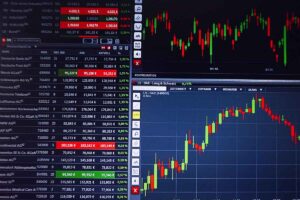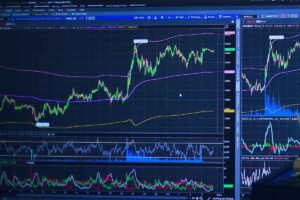What is a Stock Market?
A stock market, also known as a share market, is a financial marketplace where buyers and sellers trade stocks, which represent ownership shares in publicly traded companies. It provides a platform for companies to raise capital by issuing shares of stock to the public, and for investors to trade these shares for monetary benefits.
Companies use the stock market to raise capital for various purposes, including expanding their operations, funding research and development, repaying debt, or making acquisitions. When a company goes public, it divides its ownership into shares of stock. These shares represent ownership stakes in the company. Investors can buy and sell these shares in the stock market, transferring ownership from one party to another.
Investors, including individuals and institutional investors like mutual funds and pension funds, participate in the stock market to potentially earn returns on their investments. They can benefit from either capital appreciation (increased stock prices) or dividends (a share of the company’s profits) or both.
Stock Market Definition
The stock market is a financial marketplace where individuals and institutions buy and sell ownership shares (stocks) of publicly traded companies.
In addition to stocks, the stock market also facilitates the trading of other financial instruments, including bonds, futures, options, and exchange-traded funds (ETFs).
Types of Stock Market
Stock markets can be classified based on various criteria, such as their primary role, operational characteristics, and geographical location.
(a) Based on Primary Role
Stock markets are classified into primary markets and secondary markets based on their primary function and the nature of transactions that occur in each market.
1. Primary Market
The primary market is where companies issue new securities, such as stocks and bonds, to the general public. Investors purchase these securities directly from the issuing company through initial public offerings (IPOs).
The primary market deals with the issuance of new securities to raise capital for companies and other issuers. These securities are offered to the public for the first time.
The pricing of securities in the primary market is typically determined by the issuer or underwriters, based on factors such as company valuation, market conditions, and investor demand.
2. Secondary Market
The secondary market is where investors trade previously issued securities among themselves. Stock exchanges and over-the-counter (OTC) markets facilitate these transactions.
The secondary market deals with the buying and selling of previously issued securities that have already been through the primary market. These securities are owned by investors and are traded among investors.
Prices of securities in the secondary market are determined by supply and demand dynamics, investor sentiment, company performance, and other market forces.
(b) Based on Operational & Regulatory Aspects
Based on operational and regulatory aspects, stock markets can be classified into Stock Exchanges and Over-the-counter (OTC) Markets.
1. Stock Exchanges
Stock exchanges are highly regulated and authorized marketplaces where securities are bought and sold. Prominent examples include the New York Stock Exchange (NYSE) and the NASDAQ in the United States.
These markets provide a centralized and secure platform for trading, ensuring transparency and adherence to regulatory standards. Publicly traded companies seeking to have their shares traded on a stock exchange must meet stringent listing requirements, including financial disclosure and governance standards.
2. Over-the-Counter (OTC) Market
OTC markets, in contrast, are decentralized and less regulated. Securities are traded directly between buyers and sellers, often with the assistance of electronic communication networks (ECNs) or market makers. A notable example is OTCQX, OTCQB, and Pink sheets of OTC Markets Group.
OTC markets offer flexibility but may come with higher risks. Price discovery in OTC markets can be less transparent, and liquidity levels can vary widely. Smaller companies and those who are unable or unwilling to meet the listing requirements of a stock exchange are listed in OTC markets.
(c) Based on Geographical Location
Based on their geographical location, stock markets are classified into Regional, National, and Global Stock Markets
National Stock Markets: These operate within a single country, serving domestic companies and investors.
Regional Stock Markets: Some countries have regional or local stock exchanges serving specific geographic areas.
Global Stock Exchanges: These cater to companies and investors from multiple countries.
How Does the Stock Market Work?
Stock markets function as both primary markets and secondary markets. In the primary market, companies issue new securities, such as stocks and bonds, to raise capital. In the secondary market, investors buy and sell previously issued securities among themselves. The following is a simplified overview of what actually happens in the stock market:
1. Issuance of Securities
Companies looking to raise capital for various purposes, such as funding expansion, research and development, or debt reduction, have several avenues available to them. One of the primary methods is through the issuance of securities, which can include stocks (equity) and bonds (debt).
2. Primary Market
The company conducts an initial public offering (IPO) or follow-on offerings in the primary market. An IPO is the first sale of a company’s stock to the public, while follow-on offerings involve additional sales of securities.
3. Investor Participation
Investors, both individual and institutional, purchase these newly issued securities in the primary market. This allows them to acquire ownership in the company.
4. Stock Exchanges or OTC Markets
After the securities are initially sold in the primary market, they become available for trading in secondary markets. These secondary markets can be either stock exchanges or over-the-counter (OTC) markets.
In stock exchanges, such as the New York Stock Exchange (NYSE) and the NASDAQ, securities are traded in a highly regulated and centralized environment. Only the stocks of listed companies are available for trading in stock exchanges. Buyers and sellers can access exchanges through stockbrokers, and the exchange ensures transparency and compliance with regulatory standards.
OTC markets, like the Pink Sheets, are decentralized and less regulated. Here, securities such as stocks and bonds are traded directly between buyers and sellers. Many smaller or less-established companies are listed on OTC markets because they may not meet stock exchange listing requirements.
5. Stock Brokers or Brokerage Firms
Investors and traders access stock exchanges through brokerage firms, often through their online platforms. Brokerages act as intermediaries, connecting buyers and sellers and facilitating the exchange of securities.
6. Trading and Price Discovery
Once securities are available for trading in secondary markets, their prices are determined by the interaction of supply and demand. This process, called price discovery, helps establish the fair market value of the securities.
Investors, both individual and institutional, place buy and sell orders through their brokerage accounts. They specify the number of shares and the price at which they want to buy or sell.
7. Market Makers
In some markets, entities known as market makers facilitate trading by continuously quoting buy and sell prices for securities, adding liquidity to the market.
8. Matching Orders
Stock exchanges use computer systems to match buy and sell orders. When a buyer’s price matches a seller’s price, a trade is executed.
9. Clearing and Settlement
After a trade is executed, the clearing and settlement process ensures the transfer of ownership and funds between the parties involved. Various entities such as clearinghouses and depositories facilitate clearing and settlement.
10. Stock Market Hours
Stock exchanges have specified trading hours during which trading takes place. These hours often include a pre-market session, regular trading hours, and after-hours trading.
11. Stock Market Indexes
Stock markets have indexes that represent the overall performance of the market or specific sectors. Examples include the S&P 500, Dow Jones Industrial Average, and NASDAQ Composite.
12. Regulation and Oversight
Regulatory bodies oversee stock markets to ensure fairness, transparency, and compliance with securities laws. They set rules and regulations governing the different aspects of the market and the conduct of market participants.
Stock Market Participants
The major participants in the stock market include:
1. Stock Exchanges
Stock exchanges are the marketplaces where securities are bought and sold. They provide the infrastructure and regulatory framework for trading.
Stock exchanges organize the buying and selling of securities. They list companies’ stocks and set the rules and regulations governing trading on their platforms.
Exchanges match buy and sell orders based on price and time priority and execute trades. They provide real-time information about the prices at which securities are trading so that investors can view bid and ask prices.
2. Listed Companies
Listed companies are businesses that have undergone a process known as an initial public offering (IPO) to offer their shares for trading on a stock exchange.
To become a listed company, a business first conducts an IPO. During an IPO, the company offers a portion of its ownership (shares) to the public in exchange for capital. This process allows the company to raise funds for various purposes, including expansion, research and development, or debt reduction. Once a company is listed, it has a base of shareholders who own shares in the company.
Other available mechanisms to get listed include Direct Public Offer (or Direct Listing), Reverse Takeover (or Reverse merger), and de-SPAC merger.
3. Investors
Investors, both individual and institutional, provide the capital that fuels the stock market. They buy and sell shares in companies with the aim of making a profit from such transactions.
Investors in the stock market can be broadly categorized into two groups: individual investors and institutional investors.
Individual Investors (or retail investors): Regular people who buy and sell stocks for personal investment. They aim for wealth accumulation, retirement planning or income generation.
Institutional Investors: Large organizations, such as mutual funds, pension funds, and insurance companies, that manage money on behalf of others. They often have professional portfolio managers who make investment decisions.
4. Brokers and Brokerage Firms
Brokers and brokerage firms serve as intermediaries between investors and the stock exchanges. They provide trading platforms and services to investors and execute orders on behalf of investors.
Brokers facilitate the buying and selling of stocks. They provide online trading platforms where investors can access the stock market. These platforms offer tools, real-time market data, and order entry systems for easy trading.
When investors place orders to buy or sell securities, brokers execute these orders on their behalf. They charge commissions and fees for their services. Brokers can be broadly categorized into two groups: Full-Service Brokers and Discount Brokers.
5. Market Makers
Market makers are financial institutions or individuals that stand ready to buy or sell stocks by continuously quoting bid (buy) and ask (sell) prices for specific securities.
Market makers display the prices at which they are willing to buy and sell a particular security. These prices form a spread – the difference between the bid and ask prices. This availability of buyers and sellers at all times enhances liquidity, making it easier for investors to trade.
Market makers profit from the bid-ask spread by buying at the bid price and selling at the ask price. They manage their risk by adjusting their bid and ask prices according to market conditions and changes in supply and demand. They aim to buy low and sell high.
6. Depositories
Depositories are financial institutions responsible for the safekeeping and maintenance of securities, such as stocks and bonds, owned by investors in electronic form.
When investors buy shares, these securities are credited to their electronic accounts with the depository. Depositories hold these securities electronically, eliminating the need for physical stock certificates.
Depositories also handle the distribution of dividends or other corporate actions to investors’ accounts.
7. Clearing Houses
Clearing houses are financial intermediaries that ensure the orderly settlement of trades. They reduce counterparty risk by guaranteeing the delivery of securities and funds.
Clearing houses facilitate the settlement of trades by ensuring that the securities are delivered to the buyer and the payment is delivered to the seller. They add security and confidence to the trading process by ensuring that transactions are completed as agreed.
In the event of a trader’s default, the clearing house manages the default resolution process, which may include selling the defaulting trader’s positions to cover losses.
8. Regulators
Regulators are government or independent agencies responsible for overseeing and regulating the stock market and securities industry. They enforce rules and regulations to ensure market integrity, protect investors, and promote fair and transparent trading.
Every country has its own regulatory bodies that oversee the activities of the stock market and regulate the market. They establish and enforce rules and regulations that govern all aspects of the stock market, including trading, investor protection, and market participants’ conduct.
Regulators monitor the stock market to detect irregularities, market manipulation, insider trading, and other unlawful activities. They license and oversee market participants, such as brokers, and ensure their compliance with relevant laws and regulations.
9. Other Market Participants
Other Market Participants include:
a. Financial Advisors
They are professionals who provide financial guidance and investment advice to individuals, businesses, and institutions. This includes assessing a client’s current financial situation, understanding their financial goals, and developing a customized plan to achieve those objectives. Many financial advisors offer portfolio management services, where they design and manage investment portfolios on behalf of their clients, making buy and sell decisions to align with the client’s goals.
b. Market Analysts and Researchers
They are professionals who study the stock market, companies, and economic trends. They provide insights, recommendations, and data that assist investors in making informed decisions. They monitor and interpret market trends, such as bull or bear markets, sector rotations, and market sentiment.
c. Credit Rating Agencies
They are independent organizations that assess and evaluate the creditworthiness of issuers of debt securities, such as governments, corporations, and other entities. The primary purpose of credit rating agencies is to provide investors and the public with an informed opinion on the risk associated with investing in a particular debt security. The assessment is expressed in the form of credit ratings.
d. Transfer Agent
A Transfer Agent is a financial institution responsible for maintaining and managing the official records of securities ownership, particularly in relation to stocks and bonds. They are appointed by the company itself. The primary functions of a transfer agent include recording changes in ownership, issuing and canceling securities certificates, and distributing dividends or interest payments to investors.
e. Alternative Trading Systems (ATS)
Alternative Trading Systems (ATS), also known as dark pools or multilateral trading facilities, are platforms that facilitate the trading of financial instruments, such as stocks or bonds, outside of traditional stock exchanges. These systems provide a venue for buyers and sellers to execute trades directly with each other, typically with reduced market visibility.
f. Self-Regulatory Organizations (SROs)
SROs are independent entities established and governed by industry participants, often in collaboration with government regulators. They create and enforce industry-specific rules and regulations to ensure compliance with securities laws and market fairness.
Types of Financial Instruments in the Stock Market
Common types of financial instruments in the stock market are:
1. Stocks (Equities)
Stocks, also known as equities or shares, represent ownership in a company. When an individual or institutional investor purchases shares of a company’s stock, they become partial owners of that company.
- Common Stock: Common stockholders have voting rights and may receive dividends, but their claims on assets and earnings are secondary to preferred stockholders.
- Preferred Stock: These stocks come with fixed dividends and higher priority over common stockholders in the event of liquidation. However, preferred stockholders usually do not have voting rights.
Stocks are primarily traded on stock exchanges. However, unlisted stocks are traded on over-the-counter (OTC) markets.
2. Bonds (Fixed-Income Securities)
Bonds are debt instruments issued by governments, municipalities, or corporations to raise capital. When an investor buys a bond, they are essentially lending money to the issuer in exchange for periodic interest payments and the return of the principal amount at the bond’s maturity.
- Government Bonds: Issued by governments to raise capital, considered relatively low-risk.
- Corporate Bonds: Issued by corporations or companies to raise funds for various purposes, with varying levels of risk.
- Municipal Bonds: Issued by local governments to fund public projects, often providing tax advantages.
Bonds are traded on both stock exchanges and over-the-counter (OTC) markets.
3. Derivatives
Derivatives are financial instruments whose value is derived from the value of an underlying asset, index, or rate. They are commonly used for risk management or speculation.
- Options: Options are derivative contracts that give the holder the right (but not the obligation) to buy (call option) or sell (put option) an underlying asset at a specified price before or at the expiration date.
- Futures: Futures contracts are agreements between two parties to buy or sell an asset at a specified future date for a price agreed upon today.
Options are traded on stock exchanges and options exchanges. Futures contracts are traded on stock exchanges and futures exchanges.
4. Exchange-Traded Funds (ETFs)
ETFs are investment funds that pool together the funds from multiple investors to invest in a collection of assets, such as stocks, bonds, or commodities. Similar to mutual funds, ETFs provide diversification by holding a basket of securities.
ETFs can be passively managed, tracking the performance of a specific index, or actively managed, where fund managers make investment decisions to outperform the market.
Exchange-Traded Funds (ETFs) are traded on stock exchanges like traditional stocks.
5. Mutual Funds
Mutual funds are investment vehicles that pool money from multiple investors to collectively invest in a diversified portfolio of stocks, bonds, or other securities. These funds are managed by professional fund managers or investment companies, aiming to generate returns for the investors.
Common types include equity funds (investing in stocks), bond funds (investing in bonds), money market funds (investing in short-term, low-risk securities), and hybrid funds (a mix of stocks and bonds).
Mutual funds are not traded on stock exchanges like individual stocks or exchange-traded funds (ETFs). Instead, they are bought and sold through the fund itself at the end of the trading day at the net asset value (NAV) price.
6. Real Estate Investment Trusts (REITs)
REITs are companies that own, operate, or finance income-generating real estate. Investors can buy shares in REITs, providing an indirect way to invest in real estate without having to directly purchase or manage properties.
- Equity REITs: Own and manage income-producing real estate. The majority of a typical REIT’s revenue comes from rent payments.
- Mortgage REITs: Invest in mortgages or mortgage-backed securities, providing financing for real estate transactions. Their income is generated from the interest on these loans.
- Hybrid REITs: Combine characteristics of both equity and mortgage REITs, diversifying their revenue streams.
REITs are publicly traded on major stock exchanges. Investors can buy and sell REIT shares like other publicly traded stocks. Investors can also purchase a REIT mutual fund or REIT exchange-traded fund (ETF).
7. Treasury Bills
Treasury Bills, commonly referred to as T-Bills, are short-term debt securities issued by a government, typically with maturities ranging from a few days to one year.
Unlike traditional bonds, T-Bills do not make periodic interest payments. Instead, they are issued at a discount to their face value, and the investor receives the face value at maturity. The difference between the purchase price and face value represents the interest earned.
After the initial issuance, T-Bills can be traded in the secondary market. Investors looking to buy T-Bills in the secondary market can do so through brokerage accounts or financial institutions.
8. Commercial Paper (CP)
Commercial Paper (CP) is a short-term, unsecured debt instrument issued by corporations or financial institutions to meet short-term funding needs. It represents a promissory note, where the issuer promises to pay the holder a specified amount of money on a predetermined maturity date. It usually has maturities ranging from a few days to nine months and is typically issued at a discount to its face value.
Some brokerage firms may offer Commercial Paper to their clients, especially institutional investors.
9. Commodities
Commodities refer to physical goods or raw materials that are standardized and are traded on commodity exchanges. These can include natural resources, agricultural products, precious metals, and energy resources. Unlike stocks or bonds, commodities represent tangible assets rather than financial instruments.
Common examples of commodities traded in the commodity market include:
- Precious Metals: Gold, silver, platinum
- Energy Resources: Crude oil, natural gas
- Agricultural Products: Wheat, corn, soybeans
- Base Metals: Copper, aluminum
Commodities are traded on commodity exchanges like the Chicago Mercantile Exchange (CME).
10. Rights and Warrants
Rights are financial instruments that give existing shareholders the privilege to purchase additional shares of a company’s stock at a predetermined price, known as the subscription price. These rights are usually offered to existing shareholders in proportion to their current holdings.
Warrants are similar to options and provide the holder with the right (but not the obligation) to buy or sell a specific quantity of the issuer’s stock at a predetermined price (exercise or strike price) before the expiration date.
Both Rights and Warrants are traded on stock exchanges.
Major Stock Exchanges in the World
Some of the major and most well-known stock exchanges are:
- New York Stock Exchange (NYSE)
- NASDAQ
- Shanghai Stock Exchange (SSE)
- Euronext
- London Stock Exchange (LSE)
- Tokyo Stock Exchange (TSE)
- Hong Kong Stock Exchange (HKEX)
- Toronto Stock Exchange (TSX)
- BSE (Bombay Stock Exchange)
- SIX Swiss Exchange
Who Regulates the Stock Market?
The stock market is regulated by a combination of government agencies and self-regulatory organizations (SROs) in many countries, including the United States. The specific regulatory framework can vary from one country to another, but let’s consider examples.
United States
U.S. Securities and Exchange Commission (SEC): The SEC is the primary regulatory agency overseeing the U.S. securities industry, including stock exchanges, brokerage firms, and public companies. It enforces securities laws, sets disclosure and reporting standards, and protects investors.
Financial Industry Regulatory Authority (FINRA): FINRA is a self-regulatory organization (SRO) that oversees brokerage firms and their registered representatives. It establishes and enforces industry rules and regulations.
New York Stock Exchange (NYSE) and NASDAQ: These stock exchanges have their regulatory arms that oversee compliance with exchange-specific rules and regulations. For example, NYSE Regulation oversees NYSE-listed companies.
United Kingdom
Financial Conduct Authority (FCA): The FCA is the primary regulatory body overseeing the financial services industry in the United Kingdom, including stock markets. It sets rules, enforces regulations, and ensures market integrity.
London Stock Exchange (LSE): The LSE is a major stock exchange in the UK and has its regulatory function to enforce exchange-specific rules.










